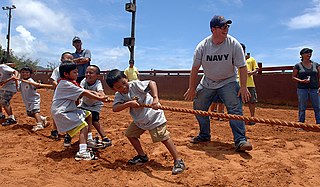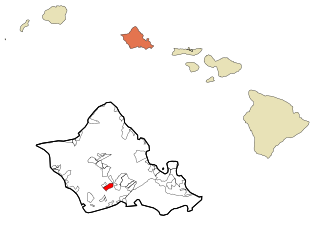This article is about the demographic features of the population of the Cayman Islands, including population density, ethnicity, religious affiliations and other aspects of the population.

Hawaii is a state of the United States of America located in the Pacific Ocean. It is the only U.S. state located outside North America, the only island state, and the only state in the tropics.

Oceania is a geographic region that includes Australasia, Melanesia, Micronesia and Polynesia. Spanning the eastern and western hemispheres, Oceania has a land area of 8,525,989 square kilometres (3,291,903 sq mi) and a population of over 41 million. When compared to continents, the region of Oceania is the smallest in land area and the second smallest in population after Antarctica.

The population of Puerto Rico has been shaped by Amerindian settlement, European colonization especially under the Spanish Empire, slavery and economic migration. This article is about the demographic features of the population of Puerto Rico, including population density, ethnicity, education level, health of the populace, economic status, religious affiliations and other aspects of the population.

Oahu, also known as "The Gathering Place", is the third-largest of the Hawaiian Islands. It is home to roughly one million people—about two-thirds of the population of the U.S. state of Hawaii. The island lies within Honolulu County and the state capital, Honolulu, is on Oahu's southeast coast.

The United States is the third-most populous country in the world, with an estimated population of 330,052,960 as of August 2, 2020. The United States Census Bureau shows a population increase of 0.75% for the twelve-month period ending in July 2012. Though high by industrialized country standards, this is below the world average annual rate of 1.1%. The total fertility rate in the United States estimated for 2019 is 1.71 children per woman, which is below the replacement fertility rate of approximately 2.1.
Haole is a Hawaiian term for individuals who are not Native Hawaiian or Polynesian. In Hawaii, it may mean any foreigner or anything else introduced to the Hawaiian islands of foreign origin.

Scouting in Hawaii began in the 1900s. It serves thousands of youth in programs that suit the environment in which they live.

Ahuimanu or ʻĀhuimanu is a census-designated place (CDP) in the City & County of Honolulu, Hawaii, United States, on the island of Oahu. In Hawaiian ʻāhui-manu means "cluster of birds".

Kahuku is a census-designated place (CDP) in the Koolauloa District on the island of Oahu, County of Honolulu, Hawaii, United States. In the Hawaiian language, ka huku means "the projection", presumably a reference to Kahuku Point nearby, the northernmost point of land on the island of Oahu. As of the 2010 Census, Kahuku had a population of 2,614.

Māʻili is a census-designated place (CDP) in the Waiʻanae District on the island of Oʻahu, City & County of Honolulu, Hawaiʻi, United States. In Hawaiian, māʻili means "pebbly", referring to rounded stones at the shore. Māʻili is located along Farrington Highway on Oʻahu’s Leeward Coast, between Māʻili Beach Park to the west and Lualualei Valley to the east. It is located 1.4 miles south of the town of Waianae, separated by the Māʻiliʻili Stream, and 1.5 miles north of Nanakuli. As of the 2010 Census, the town population was 9,488. Māʻili has one 7-Eleven, a gas station, and a few residential developments. The town is also home to several dairy farms and vegetable plots. Two tall, red antennae near the mouth of the Lualualei Valley are parts of the Navcom Radio Transmitting Facility, and were the tallest man-made structures in the Western Hemisphere at 1,503 feet when they were built in 1972. The town has an elevation of twenty feet.

Waimānalo is a census-designated place (CDP) in the City & County of Honolulu, in the District of Koʻolaupoko on the island of Oʻahu, Hawaii, United States. This small windward community is located near the eastern end of the island. In the Hawaiian language Waimānalo means "potable water"; it is so named for the many brackish ponds in the area that were used for irrigation. As of the 2010 Census, the CDP had a population of 5,451.

Waimānalo Beach is a census-designated place (CDP) located in the City & County of Honolulu, in the District of Koʻolaupoko, on the island of Oʻahu in the U.S. state of Hawaiʻi. This small windward community is located near the eastern end of the island, and the climate is dry. As of the 2010 Census, the CDP had a population of 4,481. This neighborhood is close to, but somewhat separate from Waimānalo, although the two form a single community.

Waipahu is a former sugarcane plantation town and now census-designated place (CDP) located in the ʻEwa District on the island of Oʻahu in the City & County of Honolulu, Hawaiʻi, United States. As of the 2010 Census, the CDP population was 38,216. The U.S. postal code for Waipahu is 96797.

The Hawaiian Islands are an archipelago of eight major islands, several atolls, numerous smaller islets, and seamounts in the North Pacific Ocean, extending some 1,500 miles from the island of Hawaiʻi in the south to northernmost Kure Atoll. Formerly the group was known to Europeans and Americans as the Sandwich Islands, a name that James Cook chose in honor of the then First Lord of the Admiralty John Montagu, 4th Earl of Sandwich. The contemporary name, dating from the 1840s, is derived from the name of the largest island, Hawaiʻi Island. The islands were first known to Europeans after the expedition of Álvaro de Saavedra Cerón in 1527.
Customs and etiquette in Hawaii are customs and general etiquette that are widely observed in the Hawaiian Islands. In most cases, these will be observed by long-time residents and Native Hawaiians. Some customs are unique to certain ethnic groups but are commonly observed and known by all residents.
Haunani-Kay Trask (1949) is a Hawaiian nationalist, educator, political scientist, author, and professor emeritus at the University of Hawaii at Manoa. Trask is the producer of the award-winning documentary Act of War: The Overthrow of the Hawaiian Nation (1993), winning nine different awards in three different countries. Trask helped to establish the Gladys Brandt Kamakakuokalani Center for Hawaiian Studies at the University of Hawaii at Manoa. Trask authored two books, Eros and Power: The Promise of Feminist Theory (1984), and From a Native Daughter: Colonialism and Sovereignty in Hawaiʻi (1993). She also published two books of poetry, Night Is a Sharkskin Drum (1994) and Light in the Crevice Never Seen (1999). Trask co-wrote and co-produced the award-winning documentary, Act of War: The Overthrow of the Hawaiian Nation and developed an educational CD-ROM on the Hawaiian Sovereignty movement entitled Haunani-Kay Trask: We Are Not Happy Natives (2002). In March 2017, Hawaiʻi Magazine recognized her as one of the most influential women in Hawaiian history.
The Chinese in Hawaiʻi constitute about 4.7% of the state's population, most of whom (75%) are Cantonese people with ancestors from Zhongshan in Guangdong. This number does not include people of mixed Chinese and Hawaiian descent. If all people with Chinese ancestry in Hawaiʻi are included, they form about 1/3 of Hawaii's entire population. As United States citizens, they are a group of Chinese Americans. A minority of this group have Hakka ancestry.
Race and ethnicity in the United States is a complex topic because the United States of America has a racially and ethnically diverse population. At the federal level, race and ethnicity have been categorized separately.
Non-Hispanic whites are European Americans, Middle Eastern Americans, and North African Americans that speak English as a native language as defined by the United States Census Bureau.












